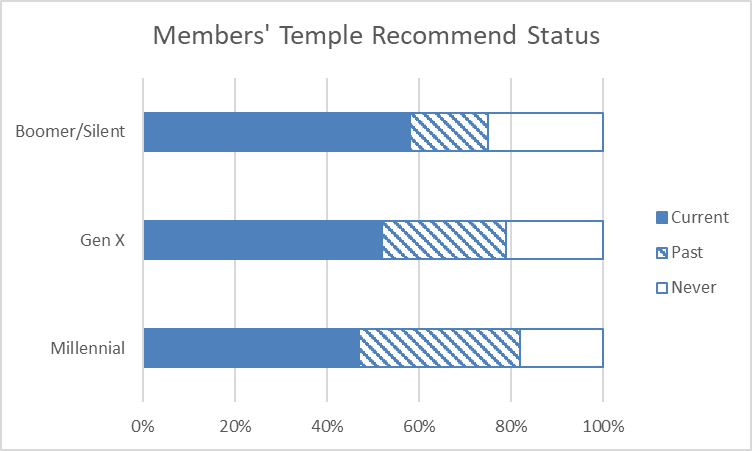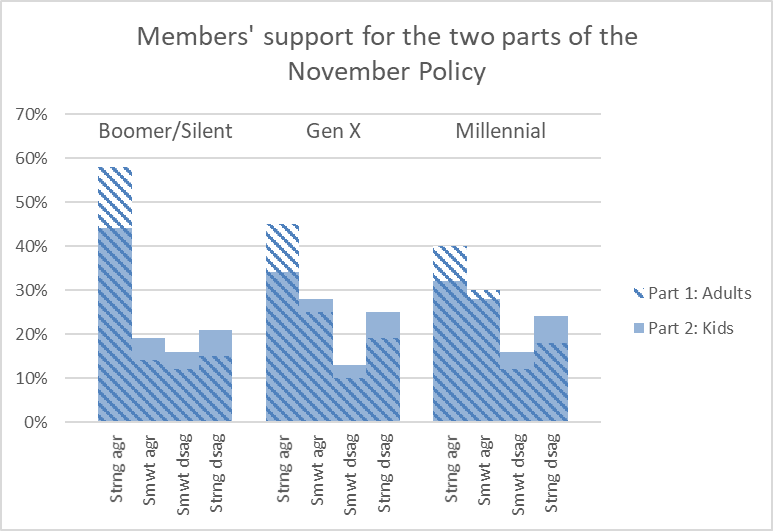Of all the discussions I read on the Bloggernacle, probably my favorite are the ones where people share their experience with the church. I love to hear about people’s experience with YW activities or missions or weird Sunday School classes. Church policies and doctrines and history can be interesting too, but it’s really the contemporary on the ground experience that fascinates me the most. Given this, I’m really the perfect target audience for Jana Riess’s book The Next Mormons.
The book was published in early 2019, which I know feels like about a decade ago in coronavirus time, and I know I’m slow in getting around to comment on it, and that if you’re reading this, it’s likely you’ve already read it. But I’ll continue just in case you haven’t. The heart of the book is a survey of American Mormons that Riess and Benjamin Knoll designed and had carried out in late 2016. They got responses from over 1,100 current Mormons and over 500 former Mormons. They asked a ton of interesting questions that Riess reports results on in the book. For example, they asked about personal beliefs and worship and spiritual practices, serving missions, temple worship, and family size, as well as more controversial issues like women’s ordination, the priesthood/temple ban, and the November policy. The subtitle of the book is “How Millennials Are Changing the LDS Church,” so her focus is clearly on generational differences. But she also reports all kinds of interesting breakdowns by variables like gender, race, and current vs. former Mormon.
This is a bit of a tangent, but I saw a reviewer on Amazon complaining that the data was gathered online–Riess and Knoll paid the survey firm Qualtrics to collect responses from members of their panel who passed a brief screening questionnaire–rather than in the “traditional” way, by phone. This complaint seems deeply out of touch to me. Of course online data gathering is imperfect and will systematically miss people who don’t use the internet much. But is this person seriously suggesting that it would have been better to random digit dial the entire United States in an effort to find a tiny fraction of the population that is Mormon? This would have been a tremendous waste of resources, not to mention that it suffers from a bias just like the online data collection does: In a time of endless calls about imaginary expiring car warranties, how many people answer the phone when they don’t recognize the number? In any case, there’s an appendix where Riess and Knoll discuss the steps they took to ensure representativeness of their sample.
So the book has a lot of data tables, and of course you know I loved them. I especially appreciated that Riess lined up her data against data from other sources, like Pew, to compare and contrast. If anything, I wished the book had had more data tables, as for example sometimes only results for one most interesting response option were reported.
Even better than the data tables, though, were the quotes from 63 additional in-depth interviews that Riess did with mostly Millennial Mormons. I thought these did an excellent job of fleshing out the patterns from the survey. It’s one thing to see in the data that younger generations are more likely to use substances forbidden by the Word of Wisdom, but it’s another to hear in people’s own words what their thinking is on this issue.
Oh, and a quick aside while I’m on the Word of Wisdom: I think Riess clearly deserves at least some of the credit for the wording of the new temple recommend question on the Word of Wisdom. Where it used to just say “Do you keep the Word of Wisdom?,” it now (after October 2019) says “Do you understand and obey the Word of Wisdom?” This seems pretty obviously traceable to Riess’s finding that lots of people who consider themselves active Mormons are drinking coffee, for example.
Anyway, I loved the book, and I think the best way I can give a flavor for how fun it is is with a couple of graphs of bits of data from it that I found interesting. Here’s one showing temple recommend status of current members by generational group. If you want to see the context in the book, it’s a reworking of Figure 3.1 on p. 55.

The three generational groups are similar in the percentage of respondents who have ever had a temple recommend, but among those who have ever had a temple recommend, the younger groups are more likely to have let theirs lapse. Of the ever recommend holders among the Boomers and Silent Generation, 77% have a current recommend, whereas among the ever recommend holders among the Millennials, only 57% have a current recommend. Riess is careful to point out that since she’s not following her respondents across time, this may be a stage of life difference rather than a generational one. So as Millennials age, perhaps they’ll become more diligent in keeping their recommends current too. I wonder too if it might be a selection effect, where the Boomer and Silent Generation respondents have had more chances to leave the Church, so only the most committed people remain, and those people are the ones most likely to keep their recommends current. In any case, whatever the reason, I find the pattern intriguing and unexpected.
Here’s another graph that shows current members’ support for the November Policy. I’ve abbreviated in the labels, but Part 1 is the automatic Church discipline for adults in a same-sex marriage, and Part 2 is withholding of Church ordinances to their children. Also, in case it isn’t clear, Stng agr = Strongly agree, Smwt agr = Somewhat agree, Smwt dsag = Somewhat disagree, and Stng dsag = Strongly disagree. If you’re comparing in the book, this data comes from Table 7.2 on p. 144.
 The oldest generational groups are markedly more supportive of the first part of the policy than the younger groups. Moving from the first part to the second part shifts all the groups toward more disagreement (rightward in the graph) and makes them look more similar to each other. This reflects what I saw anecdotally, that even people who were on board with excommunicating adults for entering a same-sex marriage found it needlessly cruel to also exclude their children from Church ordinances. It’s cool to see this reflected in actual data, though.
The oldest generational groups are markedly more supportive of the first part of the policy than the younger groups. Moving from the first part to the second part shifts all the groups toward more disagreement (rightward in the graph) and makes them look more similar to each other. This reflects what I saw anecdotally, that even people who were on board with excommunicating adults for entering a same-sex marriage found it needlessly cruel to also exclude their children from Church ordinances. It’s cool to see this reflected in actual data, though.
So the book is just packed with fascinating findings like these two tidbits, not to mention all the stories of individuals Riess interviewed. If you haven’t read it yet, I definitely recommend it.